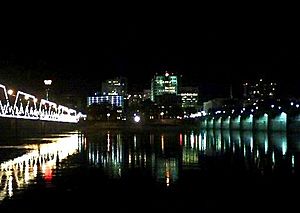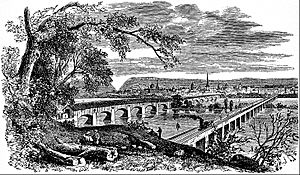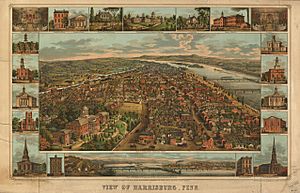History of Harrisburg, Pennsylvania facts for kids
The history of Harrisburg, the state capital of Pennsylvania in the United States, is very important to the story of America's industrial growth. Harrisburg played a big part in the country's Westward Migration, the American Civil War, and the Industrial Revolution. In the 1800s, the Pennsylvania Canal and later the Pennsylvania Railroad helped Harrisburg become one of the busiest industrial cities in the Northeast.
Contents
Early Days and First Settlers
The land where Harrisburg now stands, along the Susquehanna River, was home to Native Americans as far back as 3000 BC. They called the area "Peixtin" or "Paxtang." It was a key meeting point and resting spot for Native American traders. Important trails from the Delaware to the Ohio rivers, and from the Potomac to the Upper Susquehanna, all crossed here.
The first European to meet Native Americans in Pennsylvania was Captain John Smith in 1608. He traveled up the Susquehanna River from Virginia and met the Susquehannock tribe. Later, the Shawnee tribe, who moved around a lot, came to the Susquehanna Valley in the 1690s. Swedish and French explorers also used the Susquehanna River but did not settle in this area.
Harris's Ferry and Harrisburg's Founding
In 1719, an English trader named John Harris, Sr. settled here. Fourteen years later, in 1733, he received permission to own 800 acres of land. That same year, Harris also got a license to run a ferry. For a long time after that, the place was known as Harris's Ferry.
In 1785, John Harris, Jr., John Harris Sr.'s son, decided to plan a town on his father's land. He named it Harrisburg. William Maclay, who was John Harris Sr.'s son-in-law, officially surveyed the town in the spring of 1785. For a short time, the city was called Louisburg to honor King Louis XVI of France, who had helped during the American Revolution. However, John Harris Jr. refused to sell land for the county seat under that name. So, everyone agreed to keep the name Harrisburg, honoring his father.
Becoming a State Capital
A group of people who were against the new Federal Constitution, called anti-Federalists, met in Harrisburg on September 3, 1788. This meeting was called the Harrisburg Conference. They discussed the new Constitution and suggested 12 changes, or amendments, to it. They planned to ask the Pennsylvania legislature to consider these changes, but the request was never officially made.
In 1791, Harrisburg officially became a town. In October 1812, it was chosen as the state capital of Pennsylvania. The first stone for the new capitol building was placed in 1819 by Governor William Findlay.
The Nineteenth Century: Growth and Industry
In the early 1800s, Harrisburg was a vital stop on the Underground Railroad. This was a secret network that helped enslaved people escape to freedom. Those who escaped were often brought across the Susquehanna River, given food and supplies, and then continued their journey north, often to Canada.
In 1827, a meeting in Harrisburg led to the creation of a new law called the protective-tariff bill of 1828. This law aimed to protect American industries. In 1839, Harrison and Tyler were chosen in Harrisburg to run for President of the United States.
By the 1830s, Harrisburg was an important part of the Pennsylvania canal system and a major railroad hub. Industries like steel and iron became very important. Many different groups of people moved to Harrisburg, including the original German settlers, Scots-Irish, Welsh, French, and Huguenots. Because farming was still the main way people made a living, Harrisburg didn't develop as much in arts, music, and science as cities like Philadelphia did. In 1860, Harrisburg officially became a city.
Steel and other industries continued to be a big part of Harrisburg's economy throughout the late 1800s. The city was a center for railroad traffic and had large factories, rolling mills, and machine shops. The Pennsylvania Steel Company, which opened in nearby Steelton in 1866, was the first of its kind in the country. It was later run by Bethlehem Steel. The Harrisburg Car Manufacturing Company started in 1853, making railroad cars. In 1935, it changed its name to Harrisburg Steel Company.
Harrisburg During the Civil War
During the American Civil War, Harrisburg was a very important training center for the Union Army. Tens of thousands of soldiers passed through Camp Curtin here. It was also a key railroad center, connecting the Atlantic coast with the Midwest. Several railroads ran through the city and over the Susquehanna River.
Because of its importance, Harrisburg was a target for General Robert E. Lee's Army of Northern Virginia during his two invasions. The first time was in 1862. Lee planned to capture Harrisburg after taking Harpers Ferry, West Virginia. But the Battle of Antietam stopped him, and he had to go back to Virginia.
The Gettysburg Campaign and Harrisburg's Defense
The second attempt to capture Harrisburg was much bigger. This happened during the Gettysburg Campaign in June 1863. Two large groups of Confederate soldiers, led by Richard S. Ewell, came towards Harrisburg from the southwest. Another group, led by Jubal Early, planned to cross the Susquehanna River at Wrightsville, Pennsylvania, and attack Harrisburg from behind.
In response, Union Maj. Gen. Darius N. Couch sent troops to Camp Hill, which is about 2 miles west of Harrisburg. Workers quickly built dirt walls and forts along the western part of Bridgeport, next to Camp Hill. The two biggest forts were called "Fort Couch" and "Fort Washington."
On June 29, two Confederate cavalry groups attacked Union soldiers near Oyster Point. The Union soldiers pushed them back. This allowed Confederate officers to see Harrisburg's defenses from a distance. Ewell got ready to attack, but on the same day, Lee ordered him to pull back. Lee had found out that the Union Army of the Potomac was closer than he thought. He wanted to gather his forces near the South Mountain range to fight the approaching Union army. This led to the Battle of Gettysburg.
Ewell left two cavalry units behind at a place called Sporting Hill, on the west side of Camp Hill. Union Brigadier General William F. Smith sent two groups of militia soldiers and a cavalry company to find the Confederates. The two sides met the next day, fighting a short battle at Sporting Hill. The Confederates then left. Many people consider this to be the northernmost battle of the Civil War.
The Twentieth Century: Modernizing and Challenges
On February 2, 1897, the Capitol building was badly damaged by a fire. Construction of a new capitol began, and it was expected to cost between $5 million and $10 million. However, by the time it was finished in 1906, the cost had risen to $12.5 million. The dedication of the new Capitol was held on October 4, and President Theodore Roosevelt attended.
In 1902, Vance McCormick was elected mayor of Harrisburg. He was part of the City Beautiful movement, which aimed to make cities more attractive. Mayor McCormick immediately started projects to improve Harrisburg. He made the city park system much larger, built steps along the Susquehanna River (which are still there today), paved seventy miles of roads, and improved the city's water system. During this time, the city's population grew from 51,000 to 73,000 people.
The Pennsylvania Farm Show, a large yearly event about agriculture, first took place in 1917. It has been held every January since then. Today, the show is held at the Pennsylvania Farm Show Complex & Expo Center.
On February 14, 1964, the Harrisburg Area Community College (HACC) was started. It was the first community college in Pennsylvania. In March 1965, the City of Harrisburg sold the college 157 acres of land in Wildwood Park for a permanent campus. The main buildings were finished in 1967. HACC now has other campuses in cities like Lebanon, Lancaster, Gettysburg, and York, in addition to its main campus in Harrisburg.
In June 1972, Harrisburg experienced another flood caused by the heavy rains from Hurricane Agnes.
Three Mile Island Incident
On March 28, 1979, the Three Mile Island nuclear power plant, located down the Susquehanna River from Harrisburg, had a partial meltdown. This means part of the reactor core overheated. Even though the problem was contained and only a very small amount of radiation was released, people were still worried that a full evacuation might be needed. Governor Richard Thornburgh suggested that pregnant women and young children living within five miles of the plant should leave the area. About 5,000 people were included in this suggestion, but 140,000 people chose to leave the area.

After many years of economic struggles, Stephen R. Reed was elected mayor in 1981. He served for a very long time, until 2009, when he was unexpectedly defeated by Linda D. Thompson. Mayor Reed was the longest-serving mayor of Harrisburg. Once elected, he immediately started projects to attract both businesses and tourists. Several museums, like the National Civil War Museum, and hotels, such as the Hilton Harrisburg and Towers, were built during his time as mayor. New office buildings and homes were also constructed. Several semi-professional sports teams, including the Harrisburg Senators baseball team and the Harrisburg City Islanders soccer team, began playing in the city while he was mayor.
The Twenty-First Century
In 2011, the city of Harrisburg filed a Chapter 9 bankruptcy petition. This is a legal step for cities that are having serious financial problems.



